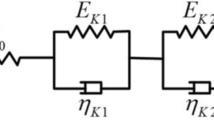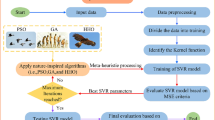Abstract
An inverse modeling process is proposed to estimate the actual elasticity modulus of a high arch dam based on unconstrained Lagrange support vector regression (ULSVR) and monitoring data. The proposed ULSVR eliminates the inequality and equality constraints to improve the iteration speed, especially for large repeated calculations, and the process takes advantage of the culture genetic algorithm (CGA) by importing the belief space, which utilizes social knowledge to guide the generations to accelerate the evolution speed. Then, CGA is used to optimize the parameters of ULSVR and seek the optimal elasticity modulus combination. The inverse modeling procedure is successfully applied to optimize the zoned elasticity modulus of the Jinping high arch dam and foundation in its initial impound period. The inversion analysis shows that the actual modulus is larger than the experimental results, showing that the actual situation is safer than the design condition.

















Similar content being viewed by others
References
Zhang L, Liu YR, Yang Q (2015) Evaluation of reinforcement and analysis of stability of a high-arch dam based on geomechanical model testing. Rock Mech Rock Eng 48:803–818
Xia Y, Li C, Zhao X, Zhang Z (2015) Mechanism research of arch dam abutment forces during overload. Math Probl Eng 2015:1–12
Mata J, Tavares de Castro A, Sá da Costa J (2014) Constructing statistical models for arch dam deformation. Struct Control Health Monit 21:423–437
Li F, Wang Z, Liu G, Fu C, Wang J (2015) Hydrostatic seasonal state model for monitoring data analysis of concrete dams. Struct Infrastruct Eng 11:1616–1631
Mata J (2011) Interpretation of concrete dam behaviour with artificial neural network and multiple linear regression models. Eng Struct 33:903–910
Sevim B, Altunişik AC, Bayraktar A, Akköse M, Adanur S (2011) Estimation of elasticity modulus of a prototype arch dam using experimental methods. J Mater Civil Eng 24:321–329
Topçu İB, Uğurlu A (2007) Elasticity theory of concrete and prediction of static E-modulus for dam concrete using composite models. Teknik Dergi 18:4055–4067
Kavanagh KT, Clough RW (1971) Finite element application in the characterization of elastic solids. Int J Solids Struct 7:11–23
Jianping Y, Xisheng H (1994) The influence of the water level and other factors on the inversion of the dam body. J Hohai Univ 1:99–101
Chongshi G, Zhongru W (1996) The convolusive analysis on deformation parameters of dam body and its foundation with whole reservoir bed. J Hydroelectr Eng 3:43–48
Yan X, Huaizhi S, Zhongru W (2004) Inverse analysis of mechanical parameters based on dam safety monitoring data. J Hydraul Eng 8:98–102 (In Chinese)
Chi S, Ni S, Liu Z (2015) Back analysis of the permeability coefficient of a high core rockfill dam based on a RBF neural network optimized using the PSO algorithm. Math Probl Eng 118:1–15
Hongzhong X, Zhongru W, Xuehong L (2002) Inversion of dan elastic modulus by fuzzy neural network. J Hohai Univ (Natural Sciences) 30:14–17
Peng L, Huaizhi S, Guijin Z (2011) Study of interval parameters back analysis of dam body and rock foundation based on RNN model. Rock Soil Mech 32:547–552
Bo L, Baosong X, Jinkun W, Jing H, Guanglei X (2008) Back analysis of dam mechanical parameters based on least squares support vector machine. Chin J Geotech Eng 30:1722–1725
Yu Y, Zhang B, Yuan H (2007) An intelligent displacement back-analysis method for earth-rockfill dams. Comput Geotech 34:423–434
Fei K, Junjie LI, Qing XU (2009) Ant colony clustering radial basis function network model for inverse analysis of rockfill dam. Yanshilixue Yu Gongcheng Xuebao/Chin J Rock Mech Eng 28:3639–3644
Gu H, Wu Z, Huang X, Song J (2015) Zoning modulus inversion method for concrete dams based on chaos genetic optimization algorithm. Math Probl Eng 2015:1–9
Zheng D, Cheng L, Bao T, Lv B (2013) Integrated parameter inversion analysis method of a CFRD based on multi-output support vector machines and the clonal selection algorithm. Comput Geotech 47:68–77
Barakat N, Bradley AP (2010) Rule extraction from support vector machines: a review. Neurocomputing 74:178–190
Basak D, Pal S, Patranabis DC (2007) Support vector regression. Neural Inf Process Lett Rev 11:203–224
Deng X-Y, Yang D-H, Liu T, Li Y, Yang B-J (2010) Performance analysis of least squares support vector regression filtering system. Chin J Geophys Chin Ed 53:2004–2011
Zhang S, Zhao S, Sui Y, Zhang L (2015) Single object tracking with fuzzy least squares support vector machine. IEEE Trans Image Process 24:5723–5738
Musicant DR, Feinberg A (2004) Active set support vector regression. IEEE Transact Neural Netw 15:268–275
Balasundaram S, Gupta D, Kapil (2014) Lagrangian support vector regression via unconstrained convex minimization. Neural Netw 51:67–79
Balasundaram S, Kapil (2010) On Lagrangian support vector regression. Expert Syst Appl 37:8784–8792
Mangasarian OL, Musicant DR (2001) Lagrangian support vector machines. J Machine Learn Res 1:161–177
Yuan X, Yuan Y (2006) Application of cultural algorithm to generation scheduling of hydrothermal systems. Energy Convers Manag 47:2192–2201
Su H, Wen Z, Sun X, Yang M (2015) Time-varying identification model for dam behavior considering structural reinforcement. Struct Saf 57:1–7
Acknowledgments
This research has been partially supported by the National Natural Science Foundation of China (Grant Nos. 51139001, 41323001, 51479054, 51279052); the Research Fund for the Doctoral Program of Higher Education of China (Grant No. 20130094110010); the Fundamental Research Funds for the Central Universities (2014B36914); the Central University Basic Research Project (Grant No. 2015B20714); and the Priority Academic Program Development of Jiangsu Higher Education Institutions.
Author information
Authors and Affiliations
Corresponding author
Rights and permissions
About this article
Cite this article
Liu, C., Gu, C. & Chen, B. Zoned elasticity modulus inversion analysis method of a high arch dam based on unconstrained Lagrange support vector regression (support vector regression arch dam). Engineering with Computers 33, 443–456 (2017). https://doi.org/10.1007/s00366-016-0483-9
Received:
Accepted:
Published:
Issue Date:
DOI: https://doi.org/10.1007/s00366-016-0483-9




